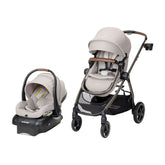6 Practices to Avoid During Labor: What You Need to Know

Updated 19 Dec 2024
Let’s be honest – there’s a good reason it’s called labor. Giving birth is hard work! The good news, though, is that your body is made to take on this seemingly Herculean feat. Tradition, instinct, and science are all on your side. While no one can guarantee you the perfect labor and delivery, research does tell us there are two important ways you can make your birth experience as healthy and safe as possible.
- Make decisions that reinforce and aid your body’s natural capacity to give birth.
- Stay away from procedures that impede your body’s natural abilities, unless there is an important medical reason for them.
It’s reasonable to choose to assist your body with the work it can do naturally instead of disrupting and complicating the process. Nevertheless, for all the amazing, life-saving advantages modern medicine provides, many of today’s routine interventions and techniques may result in longer labors, increased pain, unnecessary fetal distress, and an increased risk of C-section.
What Should You Not Do While Giving Birth?
Women and their healthcare providers can make labor simpler and safer by avoiding certain practices during labor. Lamaze International, the leading childbirth education and advocacy organization, has developed six simple recommendations that support your body in doing what it is designed so well to do—birth your baby. These practices are grounded in extensive research and supported by the World Health Organization.
Here’s what they recommend to avoid complications before and during labor and to help you have a safer and healthier birth:
1. Avoid procedures designed to initiate, sustain, or end labor for convenience.
For most people, labor will start on its own when all components – the baby, the mother’s body, the hormones – are ready. Obviously, labor runs more smoothly when the entire system is prepared for go-time.
There are certain instances when a healthcare provider might recommend inducing labor for various reasons, primarily when there's a concern for the mother's or baby's health (e.g., placental abruption or gestational diabetes). Elective labor induction, on the other hand, is the artificial initiation of labor according to an arbitrary schedule when there's no medical need (e.g., living far from the hospital or a history of rapid deliveries). According to the Mayo Clinic, inducing labor carries a variety of risks, including:
- Failed induction. If appropriate measures don't result in a vaginal birth after more than 24 hours, a C-section may be necessary.
- Low fetal heart rate. Medications used to start the process can decrease the baby's oxygen supply and lower its heart rate.
- Infection. Artificially rupturing membranes may increase the risk of infection for both mother and baby.
- Uterine rupture. On rare occasions, the uterus may rip along the scar line from a previous surgery or C-section. Uterine rupture results in an emergency C-section and possible hysterectomy.
- Bleeding after delivery. Artificial induction increases the possibility that the uterus won't properly tighten after delivery, leading to serious bleeding.
If your healthcare provider has determined you need to be induced for medical reasons, Lamaze International advises that there are ways to still keep your labor as natural as possible.

2. Avoid sitting still during labor.
Moving around during labor helps you bear the increasingly powerful contractions which, in turn, signal your body to proceed with labor. It also helps ease the baby into position in your pelvis and prepare for delivery through the birth canal. Evidence shows that women who remain vertical and mobile during labor tend to have reduced labor time, fewer interventions, less intense pain, and higher overall satisfaction with the birth experience than women who give birth lying down.
3. Avoid trying to go it alone.
Labor is an incredibly vulnerable experience in a woman’s life, and she tends to fare better when surrounded by encouraging people she trusts. Research shows that having continuous labor support in the room during labor (whether from a doula, a partner, or a friend) improves maternal health and increases positive outcomes. Your birthing partner should encourage and respect you, as well as help create a space where you feel safe to perform the difficult task of birthing a baby without unnecessary additional stress.
Massage offers soothing relief to many laboring women. Ask your labor partner to use Zoey Naturals Soothing Lavender Body Oil to moisturize and comfort your skin while you’re doing the hard work of readying your body to deliver a baby. Zoey Naturals entire line of family products is free of harsh chemicals and gentle on the environment.

Zoey Naturals Soothing Lavender Body Oil
4. Avoid medically unnecessary interventions.
Most U.S. births today are intervention-intensive. Interventions are procedures or treatments done to locate, control, or correct problems. These may include the use of intravenous fluids, restrictions on eating and drinking, continuous electronic fetal monitoring, epidural analgesia, episiotomy, and augmentation of labor.
Yet many birthing facilities and physicians have policies that lead to routine intervention for all women, despite their individual risks or situation. All interventions carry risks and have the potential to complicate the labor and birth process. Therefore, it is recommended to only use interventions when the woman and her healthcare provider agree that the benefits outweigh the potential risks and when safer options will be ineffective. When possible, select a birth setting that is less likely to implement these routine interventions.
5. Avoid giving birth on your back and ignoring your body’s urge to push.
Most women in the United States are still giving birth lying on their backs, are limited in how long they can push, and are coached to push forcefully by their care providers. Research does not support these methods. Current evidence shows that allowing the mother to assume the most comfortable position, urging them to push in response to what they feel, and allowing them to push for as long as she and the baby are doing well are all advantageous approaches.
6. Avoid separating mother and baby after birth.
Experts advise healthy newborns receive immediate, uninterrupted skin-to-skin care following a vaginal birth and during and after a C-section for all stable mothers, whether they intend to breastfeed or not. Any routine care done following birth can be done with the baby skin-to-skin on the mother’s chest. Research shows that unlimited opportunities for skin-to-skin care and nursing promote optimal maternal and child outcomes.

The Bottom Line What to Avoid During Labor
These practices are designed based on years of research to simplify your birth process with an informed approach that helps alleviate your fears and manage pain. To learn more, download the Lamaze Healthy Birth Practice Paper, available in eleven languages.









